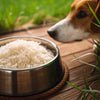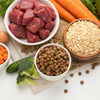What's the Best Dog Food for Weight Loss? A Comprehensive Guide for Pet Owners
- Houndsy
Table of Contents
- Introduction
- Understanding Canine Obesity
- Key Nutritional Components for Weight Loss
- Criteria for Choosing the Best Dog Food for Weight Loss
- The Best Types of Dog Food for Weight Loss
- Portion Control and Feeding Strategies
- Exercise: Pairing Diet with Activity
- Conclusion
- Frequently Asked Questions (FAQ)
Introduction
Did you know that nearly 56% of dogs in the U.S. are classified as overweight or obese? This staggering statistic highlights a growing concern among pet owners, as excess weight can lead to a multitude of health issues, including diabetes, arthritis, and heart disease. As devoted dog parents, we want our furry companions to live long, healthy lives, and maintaining a healthy weight is crucial to achieving that goal.
In this blog post, we will dive deeply into the question: What's the best dog food for weight loss? We will explore the nutritional requirements that promote effective weight management, discuss the best types of dog food available, and share strategies to help your dog shed those extra pounds. By the end of this article, you will be equipped with the knowledge to make informed choices that will benefit your dog's health and well-being.
We invite you to reflect on your pet's current diet and feeding routine. Are you providing the best possible nutrition to support their weight loss journey? Together, let’s explore how we can elevate the feeding experience for our dogs while ensuring their long-term health.
Understanding Canine Obesity
The Importance of Weight Management
Canine obesity is not just a cosmetic issue; it impacts a dog's quality of life and longevity. Being overweight can lead to serious health complications, including joint problems, reduced mobility, and a shorter lifespan. Keeping our furry friends within a healthy weight range is essential for their overall happiness and vitality.
Recognizing the Signs
Before we delve into the best dog food for weight loss, let’s discuss how to determine if your dog is overweight. Here are some signs to look for:
- Rib Check: You should be able to feel your dog’s ribs without excessive pressure. If you can’t feel them, your dog may be overweight.
- Waist Measurement: When viewed from above, your dog should have a noticeable waist. If their belly appears round and bulging, it’s time to reassess their diet.
- Energy Levels: If your dog seems less active or is reluctant to play, it could be a sign of excess weight.
Regular veterinary check-ups are crucial for monitoring your dog’s weight and overall health.
Key Nutritional Components for Weight Loss
When considering what's the best dog food for weight loss, we must recognize the critical components that should be included in your dog's diet.
High Fiber Content
Fiber plays a significant role in helping dogs feel fuller for longer periods. Foods that are rich in fiber can aid in digestion and help regulate bowel movements. Ideal sources of fiber include:
- Vegetables: Carrots, peas, and sweet potatoes are excellent options.
- Fruits: Apples (without seeds) and blueberries can serve as healthy snacks.
Low-Calorie Options
Choosing dog food with fewer calories per cup is essential for weight loss. This allows for proper portion sizes while still enabling your dog to lose weight. Look for brands that specifically market low-calorie diets.
Lean Proteins
A diet rich in high-quality lean protein, such as chicken, turkey, or fish, supports muscle maintenance while promoting fat loss. Protein is essential for keeping your dog feeling satisfied and preventing muscle loss during weight reduction.
Quality Ingredients
Not all dog foods are created equal. Selecting a weight-loss formula that is backed by veterinary research and adheres to the standards set by the Association of American Feed Control Officials (AAFCO) ensures that your dog receives the essential nutrients they need.
Criteria for Choosing the Best Dog Food for Weight Loss
Choosing the right dog food involves several important factors. Let’s break them down to help you make the best decision for your pet.
Consult Your Veterinarian
Before making any dietary changes, it's vital to discuss your dog’s weight loss plan with your vet. They can provide personalized recommendations tailored to your dog’s specific needs.
Life Stage Considerations
Different life stages require different nutritional needs. Puppies, adults, and senior dogs all have unique dietary requirements. Ensure you select food appropriate for your dog’s age and health condition.
Brand Quality and Reputation
Research brands known for producing high-quality dog food. Look for those that prioritize natural ingredients and have a solid reputation for pet health and safety.
Feeding Guidelines
Always adhere to the feeding guidelines provided by the manufacturer. These guidelines are typically based on the dog's weight, age, and activity level. Adjust feeding portions as necessary based on your dog's progress.
The Best Types of Dog Food for Weight Loss
Dry Dog Food
Dry kibble is often the most convenient option for pet owners. Here are some of the top-rated dry dog foods for weight loss:
- Annamaet Lean: This kibble contains high-quality animal protein and is specially formulated for weight loss.
- Wellness CORE Weight Management: A high-protein, low-fat choice that keeps dogs satisfied while helping them shed pounds.
- Merrick Grain-Free Dog Food: This protein-rich formula is excellent for larger breeds needing to maintain a healthy weight.
Wet Dog Food
Wet food can often help dogs feel fuller due to its higher moisture content. Here are some options to consider:
- Wellness CORE Pate Dog Food: This canned food is rich in protein and provides a satisfying meal that supports weight loss.
- Nutrish Zero Grain: This wet food is grain-free and made with real meat, ideal for maintaining lean muscle mass.
Fresh Dog Food
Fresh dog food is an emerging trend that offers high-quality, nutritious meals made from whole ingredients. Some excellent fresh dog food options include:
- Open Farm Gently Cooked Harvest Chicken: This fresh food option is made with human-grade ingredients and high protein content.
- The Farmer's Dog: A subscription service that delivers freshly prepared meals tailored to your dog's dietary needs.
Hypoallergenic Options
If your dog has food sensitivities, look for weight-loss foods that are also hypoallergenic. Brands like Blue Buffalo and Hill's Prescription Diet offer specialized formulas designed to meet multiple dietary needs.
Portion Control and Feeding Strategies
Understanding Daily Caloric Needs
To effectively manage your dog’s weight, it’s crucial to understand their daily caloric requirements. The general guideline is to feed a dog 30 calories per pound of body weight for weight maintenance. For weight loss, this number will be reduced, typically by 10-20%.
Meal Frequency
Feeding your dog smaller, more frequent meals can help manage hunger and prevent overeating. Dividing their daily calories into two or three meals can keep them satisfied throughout the day.
Treat Management
While treats can be an important part of training, they can also contribute to weight gain. Limit treats to no more than 10% of your dog's daily caloric intake. Opt for healthy options like baby carrots or green beans instead of high-calorie commercial treats.
Exercise: Pairing Diet with Activity
The Importance of Regular Exercise
No weight loss plan is complete without incorporating exercise. Regular physical activity can help your dog shed pounds while improving their overall health.
- Daily Walks: Aim for at least 30 minutes of exercise each day, adjusting based on your dog's breed and energy level.
- Playtime: Engage in interactive play with your dog, such as fetch or tug-of-war, to keep them active and entertained.
Monitoring Progress
Regular weigh-ins at the vet can help track your dog's progress. Adjust their diet and exercise routines based on their weight loss journey.
Conclusion
In summary, finding the best dog food for weight loss involves understanding your dog's unique nutritional needs, consulting with your veterinarian, and making informed choices about diet and exercise. By focusing on high-fiber, low-calorie, and lean protein-rich foods, while also considering the quality of ingredients, we can significantly improve our dogs' health and well-being.
As we embark on this journey together, let’s commit to being proactive about our dogs' diets and ensuring they receive the best nutrition possible. Remember, incorporating a reliable feeding solution, like the Houndsy Kibble Dispenser, can simplify portion control and elevate your dog-feeding experience.
By making small changes to our dogs' diets and lifestyles, we can make a big difference in their lives. What steps will you take today to support your dog's weight loss journey?
Frequently Asked Questions (FAQ)
Q: What is the best thing to feed a dog to lose weight?
A: The best diet for weight loss in dogs is a high-fiber, low-calorie dog food that includes lean proteins. Always consult your vet for personalized recommendations.
Q: Should I choose wet or dry food for weight loss?
A: Both wet and dry foods can be effective for weight loss. Wet food may enhance satiety due to higher moisture content, while dry food can support dental health.
Q: How much weight loss food should I feed my dog?
A: Follow the feeding guidelines on the package, but individual needs may vary. Monitor your dog's weight regularly and adjust portions as necessary.
Q: How quickly should my dog lose weight?
A: A safe weight loss rate for dogs is about 1-2% of their body weight per week. Rapid weight loss can lead to health complications.
Q: Can treats hinder my dog's weight loss?
A: Yes, treats can contribute significantly to a dog's daily caloric intake. Limit treats to 10% of daily calories and choose healthier options.
Implementing these strategies can help pave the way for a healthier, happier life for our furry friends. Let's make informed choices together, ensuring that our pets thrive!












